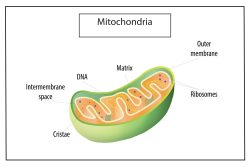 Mitochondria, often described as the powerhouses of cells, are crucial for converting nutrients into adenosine triphosphate (ATP), the energy currency of cells. Their existence is fundamental to the survival of complex organisms, including humans. However, as we age, mitochondria sustain damage and become less effective.
Mitochondria, often described as the powerhouses of cells, are crucial for converting nutrients into adenosine triphosphate (ATP), the energy currency of cells. Their existence is fundamental to the survival of complex organisms, including humans. However, as we age, mitochondria sustain damage and become less effective.
The process of energy production inherently generates harmful byproducts known as free radicals. These free radicals can wreak havoc within cells, especially harming mitochondrial DNA. Mitochondria lack the robust DNA repair mechanisms found in the nuclear DNA of cells. Over time, mutations accumulate in mitochondrial DNA, leading to a progressive decline in their ability to function effectively and produce energy. This triggers a downward spiral, further impairing mitochondrial performance. In response, several researchers are exploring therapeutic strategies to address this issue. If these efforts prove successful, they could potentially slow or reverse cellular aging.
It is well-established that mitochondria have the ability to move among cells and be taken up by surrounding cells. This knowledge has led to the idea that transplanting healthy mitochondria into older individuals could be an effective method to rejuvenate them. This concept was put into practice in a recent study, where researchers transferred mitochondria to aged subjects. Interestingly, the mitochondria used in the study were sourced from mice that were the same age, rather than from younger mice.
The mitochondria were isolated from donor tissue and then directly administered to the mice in the test group. This was done through injections into the muscle tissue of the hind legs, which provided a straightforward method of delivery. In comparison to the control group, the mice that received mitochondrial transplants exhibited enhanced mitochondrial and muscle function, as well as increased endurance.
The study revealed notable rises in basal levels of cytochrome c oxidase and citrate synthase activities, along with ATP levels in the transplanted mice compared to those given a placebo. Additionally, there was a significant increase, approximately doubled, in the protein expression of mitochondrial indicators in both oxidative and glycolytic muscle types. These improvements in muscle functionality led to marked gains in exercise endurance for the treated mice.
A significant aspect of this study is that despite the mitochondria being sourced from mice that were the same age, there was still observable improvement. This suggests that the introduction of additional mitochondria might dilute the effects of the damaged ones already present in the recipient. Essentially, the inflow of new mitochondria could be mitigating the impact of the mutated ones. Given these findings, it seems logical to hypothesize that using mitochondria from younger donors could yield even better results. Conducting a follow up research with mitochondria obtained from younger mice would be an excellent next step to test this theory.
To view the original scientific study click below:
Mitochondrial Transplantation as a Novel Therapeutic Strategy for Mitochondrial Diseases





